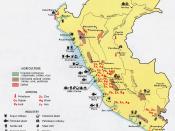Peru's gross domestic product in the late 1980s was $19.6 billion, or about $920
per capita. Although the economy remains primarily agricultural, the mining and
fishing industries have become increasingly important. Peru relies primarily on the
export of raw materials--chiefly minerals, farm products, and fish meal--to earn
foreign exchange for importing machinery and manufactured goods. During the
late 1980s, guerrilla violence, rampant inflation, chronic budget deficits, and
drought combined to drive the country to the brink of fiscal insolvency. However,
in 1990 the government imposed an austerity program that removed price controls
and ended subsidies on many basic items and allowed the inti, the national
currency, to float against the United States dollar.
About 35 percent of Peru's working population is engaged in farming. Most
of the coastal area is devoted to the raising of export crops; on the montaña and the
sierra are mainly grown crops for local consumption.
Many farms in Peru are very
small and are used to produce subsistence crops; the country also has large
cooperative farms. The chief agricultural products, together with the approximate
annual yield (in metric tons) in the late 1980s, were sugarcane (6.2 million),
potatoes (2 million), rice (1.1 million), corn (880,000), seed cotton (280,000),
coffee (103,000), and wheat (134,000). Peru is the world's leading grower of coca,
from which the drug cocaine is refined.
The livestock population included about 3.9 million cattle, 13.3 million
sheep, 1.7 million goats, 2.4 million hogs, 875,000 horses and mules, and 52
million poultry. Llamas, sheep, and vicuñas provide wool, hides, and skins.
The forests covering 54 percent of Peru's land area have not been
significantly exploited. Forest products include balsa lumber and balata gum,
rubber, and a variety of medicinal plants. Notable among the latter is the cinchona
plant, from which quinine is derived. The...


